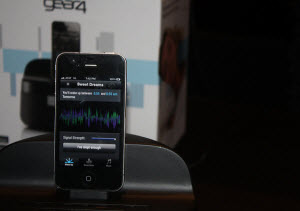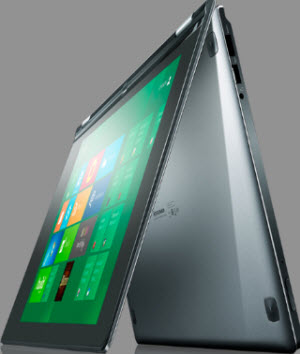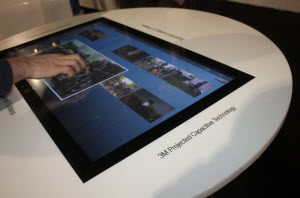The International Consumer Electronics Show is a huge festival of gadgetry, but there’s no better place to get a bead on where technology is going in the coming year.
Among the 153,000 attendees at the show in Las Vegas last week were five VentureBeat staffers who were sniffing out the big trends. This story is our list of the most evident trends among the rows and rows of gadgets at CES.
The convention is like a step into the future, with many companies showing off the TVs, smartphones, computers and tablets that they will be bringing to market in the coming months. When you see the same kind of product over and over again, that’s a good sign that it will be dominating the tech headlines in the near future.
This story was written by Dean Takahashi, Dylan Tweney, Sean Ludwig, and Devindra Hardawar. Also check out the 10 most promising products of the coming year. For fun, here’s the link to last year’s top trends from CES 2011.
 1. Connected TVs hook up with smartphones and tablets
1. Connected TVs hook up with smartphones and tablets
Manufacturers have finally realized that the majority of us don’t just sit and watch TV: We usually have a phone, a laptop or a tablet in our lap whenever we tune in. That presents some interesting opportunities to the company that can figure out how to tie multiple screens together in an interesting way. For instance, everyone from Sony to Samsung is playing with ways of “swiping” a TV show from a touchscreen tablet onto your TV with a flick of the wrist. Gestures like this point to a day when you no longer need universal remotes, because the touchscreens you already own are a far better way to browse video content, whether it comes from cable, satellite, broadcast or internet sources like Hulu and YouTube.
More interesting, perhaps, is the possibilities that a “two-screen” experience opens up for connecting your TV-watching with your social networks and the internet at large. You could be watching the NFL game on the big screen while you look up stats on your little screen. You could be chatting with friends or sharing highlights via Twitter while watching the latest episode of Downton Abbey. Panasonic’s embrace of a reimagined MySpace might be the most prominent example of this aspiration, but other manufacturers, like LG and Sony, are working on it as well. And of course Google has been attempting this for several years, though we saw very little evidence at CES that Google TV has much traction among manufacturers or customers.
The big challenge: There are no broad standards to facilitate connecting TVs and tablets, and in the absence of that, every manufacturer is trying to own the whole burrito. If someone can figure out how to create a truly cross-platform TV and mobile device system, they’ll have a good shot at capturing a huge slice of consumer attention. –Dylan Tweney
 2. Ultrabooks breathe new life into laptops
2. Ultrabooks breathe new life into laptops
Who ever thought a new shape of laptop would be one of the most interesting aspects of CES?
Intel pushed Ultrabooks — its new name for thin and light ultraportable laptops — hard at the trade show. This year alone there will be more than 75 Ultrabook models on the market, and Intel has said that it’s gearing up its biggest marketing push since the Centrino lineup for the new machines. HP had one with Gorilla Glass on its cover, while Dell had one that was made out of carbon fiber.
So what’s the big deal? Ultrabooks promise to be lighter than typical laptops, weighing in around 3 pounds for the most part, allowing them to practically disappear in your laptop bag. They’ll sport solid-state drives (SSDs), instead of traditional hard drives, which will make them extra-thin and fast. (Expect startup times under 10 seconds and practically instant resume from standby speeds.) And thanks to Intel’s next-generation Core processors, Ultrabooks will be peppy under the hood and even capable of decent 3D graphics performance.
Ultrabooks are basically everything I’ve ever wanted in a computer — except priced to be more approachable than Apple’s MacBook Air. For more on Ultrabooks, check out our recent feature: More than just hype, Ultrabooks are the future of laptop computing. –Devindra Hardawar
 3. OLED offers brighter and bigger TV screens
3. OLED offers brighter and bigger TV screens
It may be a bit early to call OLED TVs a trend, what with only two models on display this year from LG and Samsung, but after being teased with OLED technology for years now, we feel it’s time to finally get excited for these displays, which represent the next-generation of HDTVs.
Why the hype? Since the OLED displays don’t require a backlight, they’re impossibly thin (LG’s display is only 4 millimeters deep with a 1mm bezel). They’re also capable of a richer color palette, dark-as-night blacks, and brightness beyond the capabilities of LCD sets. OLED also features fast response times (it doesn’t have the fast motion issues that LCD does), as well as extremely wide viewing angles.
The 55-inch OLED displays from LG and Samsung, which are expected to be released some time this year, are the closest the technology has gotten yet to dominating consumer living rooms. Expect even more OLED displays at CES next year, and most importantly, expect their initially exorbitant prices to fall within the next few years. –Devindra Hardawar
4. Car companies embrace technology
Car companies showed up in full force at CES, with companies like Mercedes-Benz and Ford showing off the latest in connected car technology. While the consoles inside these machines don’t quite represent full-fledged computers or do everything a smartphone can do, they can now interact with our smartphones and give us all sorts of smart extras, whether it’s to talk out directions or listen to our voice commands to change the channel.
Mercedes-Benz head Dieter Zetsche debuted the mbrace2 console, which connects the dashboard to the cloud for over-the-air software updates and gives the owner access to Facebook, Google, news highlights and more from the dashboard. The mbrace2 solution will also have 3G Internet access, but it’s unclear if you’d need to purchase a data plan to use it and what limitations it might have. The Tesla Model S, pictured right, has a huge touchscreen display in its dashboard.
Another highlight of the show was Ford, which showed its Sync technology growing up with more apps for AppLink, its program in the console that interacts directly with iPhone and Android apps when the phone is connected via Bluetooth or USB. AppLink already lets you voice control apps like Pandora, Slacker, iHeartRadio and Stitcher, and now it works with a new NPR app that lets you create on-demand listening of your favorite NPR programs.
VentureBeat contributor Rocky Agrawal rightly points out that car and phone integration has a lot of road for improvement, but we believe they are at least headed full-speed in the right direction. –Sean Ludwig
 5. Gadgets for measuring our lives are proliferating
5. Gadgets for measuring our lives are proliferating
From sleep monitors like Gear4 to heart monitors such as the Basis Band, we can now get data about every facet of our lives. The trend was spearheaded by researchers who wanted a “quantified self,” or self-knowledge through numbers that measure things such as how long we sleep or how many stairs we can climb in a day. We don’t know where it will end.
The new Striiv pedometer told me that I walked more than 17,000 steps, or more than seven miles, in one day at CES. When I got back home and walked just 7,000 steps in a day, I felt like a slacker. The Gear4 Sleep Clock will use radar to calculate the exact number of minutes you slept in a night, how many minutes it took to fall asleep, and when is the ideal time to wake you up. After a year of such data, it will be much easier to wake up at exactly the lightest point in your sleep cycle. All of this is useful data, and we’re going to want to store it somewhere. And once you collect it, companies will be more than happy to bribe you in order to purchase that data from you.
This shift to quantified self gadgets is also coming with a change in attitudes about privacy, or at least it seems that way. There’s a tension between personalization and privacy. George Orwell, the author of 1984, the seminal novel about Big Brother watching you, couldn’t have planned a better way to capture everything that we do in a day. But because of the potential benefits, many people seem eager to be measured, as long as their privacy is protected. The space where you can operate privately is becoming more and more constrained. –Dean Takahashi
 6. Sensors are everywhere
6. Sensors are everywhere
If we’re going to quantify our lives, we need sensors to do it. And CES clearly showed that sensors are proliferating. Some of them aren’t new. They’re just getting better. Global Positioning Systems (GPS) sensors will soon be able to detect your location indoors. The Kinect motion-sensing system for games on the Xbox 360 is expanding to uses such as virtual shopping (Bodymetrics) and games on the PC. Since you can hack Kinect, you can also turn it into a home security system. LG showed off a smart refrigerator that can sense what kinds of groceries you have purchased and what you will need to order soon. Microphones can be used around a city to detect the exact location of a gunshot. You can stick a sensor in the ground to determine whether the soil is perfect for growing your favorite vegetable, or maybe it will recommend something else. Accelerometers, gyroscopes, compasses, touchscreens and voice recognition sensors are built into our phones. Those phones are sending all sorts of data about your activities to a data center. Rear-view mirror cameras and motion-sensing alarms alert us to hazards or thieves. Cameras are mounted on everything from flying drones to ski helmets. It’s much easier to put inexpensive surveillance cameras up to detect crime or capture a license plate for someone who speeds through a red light. Heart rate and sweat monitors add more information to motion-sensors about how fit we are. At the airport, your entire body can be scanned in the name of security. Say goodbye to the analog life. Everything analog is going digital. –Dean Takahashi
 7. There’s no more excuse for getting lost
7. There’s no more excuse for getting lost
The global positioning system (GPS) has made it a lot easier for us to find out where we need to go without printing out a Mapquest page. Just about every phone comes with Google Maps or some other way to get around. Siri on the iPhone 4S will help you find your way by letting you give it voice requests for destinations while you’re driving the car. But until recently, navigation only worked outdoors.
Now a company called CSR is going to make it even harder to get lost by introducing chips that do indoor navigation. Satellite-based GPS has always been too weak on this front because it requires a line-of-sight to the user. But the SiRFstarV GPS chips use a combination of GPS, Wi-Fi signal triangulation, and motion sensors such as gyroscopes in your phone to get a better reckoning on where you are. SiRFstarV fuses various radio signals, sensor inputs, and other location data to provide reliable and accurate positioning inside buildings. Using a cloud-based back-end service dubbed SiRFusion, the technology pulls together the various inputs to figure out where you are and where you are moving.
Companies such as Micello and Google are working to create indoor maps of big spaces such as airports or convention halls so that you can navigate from one indoor landmark to another. CSR demonstrated a working indoor navigation system at CES, and it will only be a matter of time before these things are used in smartphones. People who are chronically late will no longer be able to legitimately claim that they got lost in a maze on their way to an appointment. –Dean Takahashi
 8. Apps on the TV are gathering steam
8. Apps on the TV are gathering steam
Pretty soon, you’ll be able to play Angry Birds on a Samsung TV. That’s one of many new apps coming to TV sets, which are smart enough to be connected to the internet and can download apps from web-based App Stores. Google TV, which will debut on consumer electronics gear from Sony, Vizio and LG, has more than 500 apps in the Android Market for smart TVs. Microsoft’s Xbox Live service for the Xbox 360 game console will now let you download all sorts of entertainment apps so that you can have even more sources of movies and TV shows. OnLive is also getting installed on more TVs, including Vizio and Google TV-based sets. That means that you’ll be able to watch users playing high-end games via the television set, and eventually you’ll be able to play multiplayer games on your TV, even though you haven’t downloaded anything to the TV. Web service Pandora is now available on more than 450 devices, including a bunch of TVs. Opera showed off a new TV app store at CES. GameTree TV is offering lots of games on TV sets, coming preinstalled with a number of set-top boxes. –Dean Takahashi
 9. Next-generation tablets hit the scene
9. Next-generation tablets hit the scene
It’s easy to think that technology is static, particularly once a new gadget like the tablet has been clearly defined. But the truth is that tablets are getting better and better, and the ones coming this year are going to be leaps and bounds better than last year’s models. They’re powered by some powerful chips that could do a stand-up job running computers, yet those chips are so power efficient they won’t drain the life out of machines. Nvidia showed off a tablet from Asus that uses the ARM-based Tegra 3 processor, which can generate console-like 3D graphics for games. Asustek will use the Tegra 3 in a 7-inch tablet that will sell for $249. Intel and Qualcomm also showed off a number of tablets using their chips. A number of convertible laptops were also on display at CES, where the laptop can be twisted an easily converted to a tablet computer. Lenovo showed off its IdeaPad Yoga, a laptop that can bend over backwards and turn into a Windows 8 tablet. Many of the prototypes showed off Microsoft’s Windows 8 operating system and its Metro interface, which uses large touch-friendly icons to help users navigate through different applications. In this case, companies are not only innovating on hardware, but software as well. — Dean Takahashi
 10. Touch has become pervasive
10. Touch has become pervasive
Apple started the avalanche toward touchscreens with the iPhone in 2007 and it has been gathering momentum ever since. The technology is getting more responsive and accurate, thanks to advances in chips, display technology and glass. Samsung showed off a touchscreen that can accurately detect both finger touches and pen touches. Thanks to suppliers like Atmel, that will become more and more common. And the touch technology is benefiting from faster processing. Nvidia, for instance, showed off a technology called DirectTouch in its Tegra 3 smartphone and tablet processor. It means that Tegra’s fifth “ninja” processor can handle the processing of touchscreen inputs that are normally handled by microcontrollers. As a result, the company said that the ninja processor is much faster than microcontrollers, and can triple the performance of touchscreen processing. The consequence of better touch is that we’re seeing it just about everywhere, from giant wall-size screens to TV remote controls, which now have slick touch pads on them for better navigation. Say goodbye to the old-fashioned button. — Dean Takahashi
VentureBeat's mission is to be a digital town square for technical decision-makers to gain knowledge about transformative enterprise technology and transact. Learn More

